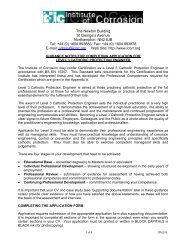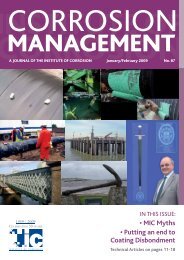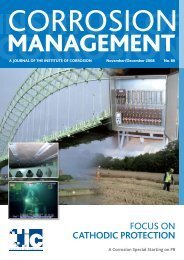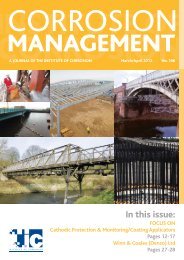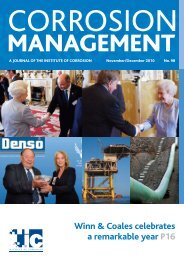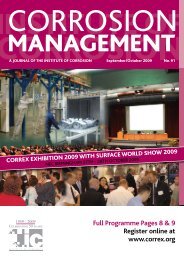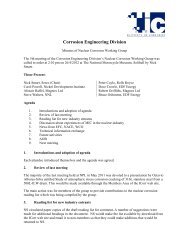In this issue: - the Institute of Corrosion
In this issue: - the Institute of Corrosion
In this issue: - the Institute of Corrosion
You also want an ePaper? Increase the reach of your titles
YUMPU automatically turns print PDFs into web optimized ePapers that Google loves.
INSTITUTENEWS<br />
Technical Topics No.32:<br />
“Science Council & how to remedy (& prevent)<br />
water line attack on coated structures”<br />
by Technical Secretary, Douglas J Mills<br />
Just under a year ago <strong>the</strong> Science Council,<br />
in <strong>the</strong>ir regular review <strong>of</strong> our procedures to<br />
award <strong>the</strong> Chartered Scientist designation<br />
found <strong>the</strong>m wanting in some ways. <strong>In</strong><br />
particular, <strong>the</strong>y were concerned about <strong>the</strong><br />
low numbers <strong>of</strong> chartered scientists that we<br />
registered. Consequently our license to award<br />
CSci was suspended pending <strong>the</strong> introduction<br />
<strong>of</strong> new, simplified, application procedures.<br />
Recently <strong>the</strong> Science Council re-visited us in<br />
Northampton to discuss lifting <strong>the</strong> suspension<br />
and I am pleased to report that <strong>the</strong>y are now<br />
satisfied that our new proposals met all <strong>the</strong>ir<br />
concerns. They were also most impressed<br />
with <strong>the</strong> premises at Northampton and <strong>the</strong><br />
commitment <strong>of</strong> our support team, Denise<br />
and Gwynneth. So <strong>the</strong> good news is that we<br />
will have our licence renewed. <strong>In</strong> connection<br />
with <strong>the</strong> main point (how to make becoming<br />
a Chartered Scientist more attractive to our<br />
members), it has been decided to approach all<br />
<strong>the</strong> ICorr Fellows <strong>of</strong>fering <strong>the</strong>m <strong>the</strong> chance to<br />
apply in a simplified process. The assumption<br />
is that if you are adjudged sufficiently<br />
estimable in <strong>the</strong> corrosion field to be a Fellow<br />
and you are applying some science in your<br />
work (and most Fellows probably do) <strong>the</strong>n<br />
you are worthy <strong>of</strong> becoming a Chartered<br />
Scientist. On <strong>the</strong> financial side Council have<br />
agreed to subsume <strong>the</strong> extra annual cost<br />
<strong>of</strong> Chartered Scientist registration into <strong>the</strong><br />
annual subscription for Fellow (i.e. it would<br />
not cost an individual Fellow who got CSci<br />
through <strong>the</strong> <strong>In</strong>stitute any more money). This<br />
seems to be good deal and so your Technical<br />
Secretary has decided to apply for Fellowship<br />
himself! (normally he eschews <strong>the</strong>se sort <strong>of</strong><br />
things – all <strong>the</strong> accolades in <strong>the</strong> world + all<br />
<strong>the</strong> money in <strong>the</strong> world, he would trade for<br />
a stroll down Kings Parade in Cambridge with<br />
Claudia Schiffer (or, if unavailable, Mrs Mills<br />
on his arm!). Anyway watch <strong>this</strong> space. We<br />
will outline <strong>the</strong> procedures and <strong>the</strong> advantages<br />
<strong>of</strong> becoming a Chartered Scientist in <strong>the</strong><br />
next edition <strong>of</strong> CM.<br />
On <strong>the</strong> technical front, I thought I would pick<br />
up on what was talked about in <strong>the</strong> last CM<br />
ie accelerated low water corrosion (ALWC).<br />
But <strong>this</strong> time instead <strong>of</strong> uncoated steel piles,<br />
<strong>the</strong> problem has occurred on coated supports.<br />
This arises from a trip to Poland (Gdansk area)<br />
that I made last week. The reason for my<br />
trip was unconnected (we have an Erasmus<br />
exchange programme with Gdansk University<br />
<strong>of</strong> Technology involving exchange <strong>of</strong> staff and<br />
students). But I was made aware <strong>of</strong> it while<br />
I was <strong>the</strong>re The main place with a problem<br />
is a pier in Gydnia (however as tourists we<br />
observed a quite similar situation on a pier<br />
in Sopot - a major resort town near Gdansk<br />
on <strong>the</strong> Baltic sea with <strong>the</strong> reputedly longest<br />
pier in Europe). The Baltic sea is interesting in<br />
having less chloride in it than normal sea water<br />
(about 0.5% I was told).But as you can see<br />
from <strong>the</strong> pictures that does not stop it being<br />
aggressive particularly at <strong>the</strong> water line. The<br />
challenge is how do you remedy <strong>the</strong> situation?<br />
It appears that <strong>this</strong> waterline area had <strong>the</strong><br />
same thickness <strong>of</strong> paint (about 150μm) as<br />
<strong>the</strong> rest <strong>of</strong> <strong>the</strong> structure. Ok for a car body but<br />
probably too thin for a steel structure exposed<br />
to a chloride environment. So how do you get<br />
<strong>the</strong> extra paint on? Removing <strong>the</strong> supports<br />
is not an option. So <strong>the</strong> remedial work has<br />
to be done in situ. There are coatings (epoxy<br />
mastic) that can be put on under water. But<br />
<strong>the</strong>n <strong>the</strong>re is <strong>the</strong> need to get <strong>the</strong> old system<br />
fan <strong>of</strong>f (could be application for waterjetting<br />
which as regular readers will know I am a big<br />
fan <strong>of</strong>f) I passed on <strong>the</strong> information to <strong>the</strong><br />
people in Gdansk about <strong>the</strong> interesting LA TREAT<br />
process discussed at <strong>the</strong> CED meeting in May<br />
and covered in <strong>the</strong> recent CM (luckily I’d taken<br />
my May/June copy <strong>of</strong> CM to Gdansk and David<br />
Nuttall’s report proved useful). It was felt that<br />
although <strong>the</strong> process was very interesting,<br />
<strong>the</strong> nature <strong>of</strong> <strong>the</strong> structure (circular coated<br />
supports) probably made it unlikely that it<br />
would be applicable. Could <strong>this</strong> problem have<br />
been identified earlier ie before it got to <strong>this</strong><br />
stage. My view is it could. Obviously paint<br />
inspectors would have picked up <strong>the</strong> lack <strong>of</strong><br />
thickness. But <strong>the</strong> lack <strong>of</strong> protection being<br />
afforded could also have been picked up by<br />
an electrochemical technique eg by making<br />
annual or biannual measurements using eg<br />
Electrochemical Noise (or Electrochemical<br />
Impedance) methods (in situ measurements<br />
on coated structures are also <strong>of</strong> great interest<br />
to <strong>the</strong> group in Gdansk). You measure at one<br />
time and it is IE9 ohms-cm2, <strong>the</strong> next time it<br />
is 1E8, <strong>the</strong> next time 1E7. You can <strong>the</strong>n assume<br />
<strong>the</strong> paint system is going to soon reach a point<br />
when it will no longer be affording protection.<br />
But before that you get an extra coat on!<br />
As usual any comments on <strong>this</strong> months TT please<br />
send to: Douglas@harrbridge.freeserve.co.uk<br />
Acknowledgment: Thanks are due to Andrzej<br />
Miszczyk (GUT) for <strong>the</strong> pictures and to both<br />
to him and Zbigniew Klenowicz for discussions<br />
relating to <strong>the</strong> technical part <strong>of</strong> <strong>this</strong> article.<br />
7



